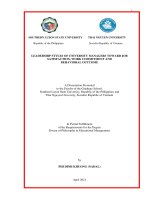Classical and behavioral ca31bf9096014d62a2ab575f9270d03d 1770645 (1)
Bạn đang xem bản rút gọn của tài liệu. Xem và tải ngay bản đầy đủ của tài liệu tại đây (24.35 KB, 3 trang )
classical and behavioral perspectives
Theories are theoretical generalizations about a certain field that are drawn from research and practical
experience to apply in practice. The theory of management is the concepts and types of management in
production and business activities. That is an important factor for scientific and effective business operations.
During the management process, managers can completely combine different management tools to increase
efficiency. The simultaneous use of classical and behavioral perspectives can be a good combination to increase
efficiency and systematic work.
The classical theory is built on the belief that workers have only material and economic needs.
Managers treat workers like machines, regardless of their social needs or job satisfaction. They train highly skilled
workers to work according to established processes to maximize productivity and profits. Classical management
theory helps to define clear management structure, functions, and activities, making work easier. In this theory,
managers can also make decisions quickly because they do not have to go through intermediaries or consult
collectives. However, in classical management, managers only try to manage. behaviors and actions of
employees, and largely ignore their attitudes and job satisfaction. As a result, employees have limited creativity
and passion for work. Furthermore, the exhaustion of labor power causes workers to fight against the policies of
governance.
Contrary to classical management theory, behavioral management theory focuses on employee behavior and
motivation. Managers understand the motivations of employee actors, including expectations, needs, interests,
and group dynamics. They are starting to see employee satisfaction and working conditions as a way to increase
productivity. They give factors to create motivation for employees such as achievement, recognition, work itself,
responsibility, and growth opportunities. Besides, managers also provide some conditions to help employees
maintain motivation such as relationships, salary, status, and stable jobs. However, the behavioral theory is based
on voluntariness and interpersonal behavior is not the same. Therefore, in order to manage employees well,
managers must predict behavior, manage and give control to be proactive in running the business. At the same
time, it is necessary to influence and orient the employees' behavior to follow a certain trajectory to achieve the
common goals of the enterprise.
Any management perspective has its advantages and disadvantages and is only suitable for a certain time.
However, combining different management tools and theories at the same time can help businesses achieve
good results. The simultaneous use of classical management theory and behavior can also be a good alternative
to management if they are combined in the right way. Every business wants its employees to work efficiently,
with high productivity, bringing many benefits to it. Nevertheless, in order to achieve that, enterprises need to
have good, enthusiastic employees with a high sense of self-discipline. Therefore, managers need to use two
management perspectives simultaneously to balance employee welfare and business productivity.
It is easy to see the connection between these two management perspectives. One side strategize, lead, and
make decisions on how to achieve the best productivity in the simplest way. However, in order to do that, there
needs to be an employee element. Therefore, the other party will create conditions for employees to develop
and have a good work ethic to create high productivity. Employees are an important factor to create the success
of the company. Good workers can also make a good company.
Classical management theory helps to streamline operational processes and increase productivity and profits.
Reasonable division of labor, dividing tasks into more specific tasks, allows organizations to use to train jobs and
assign employees to perform more effectively. At the same time, helping employees accumulate experience and
improve professional capabilities, the organization is not disturbed in terms of personnel. Along with that, the
behavioral management perspective brings good conditions to motivate employees. Managers consider
employees an important factor and their job satisfaction is the core to increasing labor productivity. For example,
they bring fair and worthy remuneration to employees. Always listen to the opinions of subordinates, and
encourage them to learn and hone their skills. It is an indirect way to implement the classical management
concept and create success at work.
For instance, the management strategy of Google .The company sets many standards, goals, and business
strategies for employees to fight for. For example, always have to find new ideas, be different, have to do things
that other competitors can't focus on quality instead of quantity... However, this company always places the
importance of staff to the top. They create a good working environment for employees, allowing them to
exchange and meet each other. Care about physical and mental health, and always let employees be proactive
and creative in their work. Therefore, Google employees are considered one of the best workers in the world. At
the same time, product quality and company reputation are also improved
In short, the simultaneous use of classical management concepts and behavior is a novel
combination. Managers can completely combine two or more different management tools to make a difference
in management, even bringing unexpected results to work. The combination of different management laws not
only helps managers develop their capabilities, but also gives employees the opportunity to create and develop.









